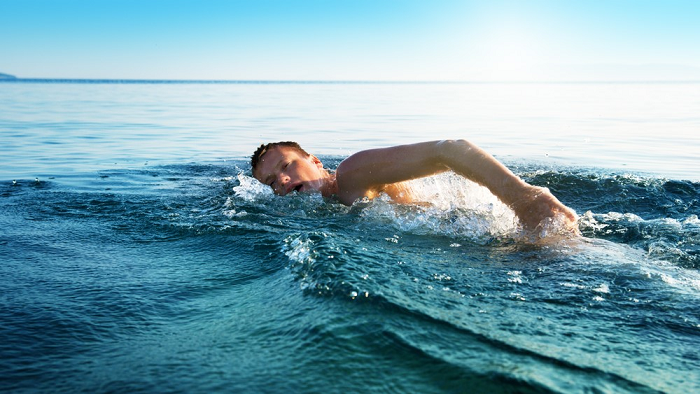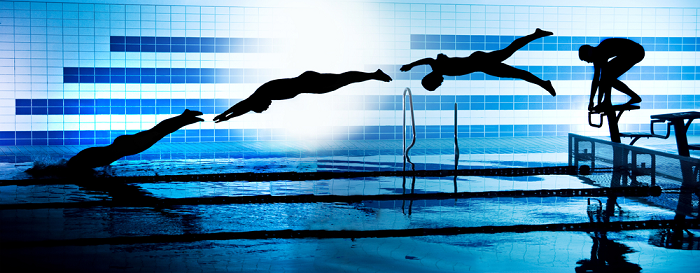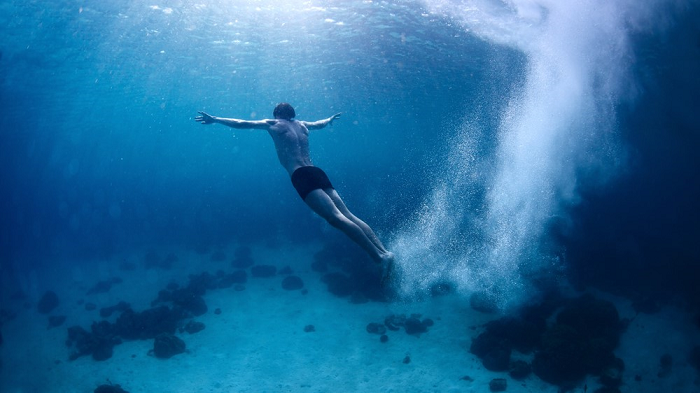Phase 1 — Building the Gentleman Spy Body
Lesson 5 — Swimming and Water Confidence
ATTENTION: Before starting the Gentleman Spy Workout, you must have a clean bill of health. This workout is designed to minimize your rate of injury — in exercise and in the rest of your life. You must practice the exercises and understand how to properly perform them. By performing the workouts recommended here, you agree that you take full responsibility for your life, choices, and actions. Anything that happens because of this program — good or bad — is your fault and your fault only.
LESSON 5: Swimming and Water Confidence

The Bahamas, the ocean, and the beach. The setting of dozens of classic Bond scenes, and beautiful clear waters. A swim down the shore to check out Dimitrios’ girlfriend, or an underwater fight wearing scuba gear, are all in a day’s work for the gentleman spy, and they should be for you too.
More than just a pastime in exotic locations, swimming competence is a basic skill that may very well save your life, or somebody else's.
To live the Gentleman Spy lifestyle, it is mandatory that you swim, and swim well.
Swim Better

Whether you don't know how to swim at all or you've been swimming your entire life, if you do not already consider yourself an expert swimmer, you owe it to yourself to check out Total Immersion. There is no better resource for developing swimming skill and water confidence than TI.
Originally designed to help triathletes become more competent swimmers, TI will teach you the techniques you need to be like a fish in the water. Start with Total Immersion's online course, then enroll in a weekend clinic if you want to go further. If you can’t find a TI clinic near you but still want in person instruction, look for Master’s swim clubs in the area and inquire about adult swim lessons.
Once you have the basics, continue working on technique and speed. Swimming fast isn’t just about swimming harder, so practice the technique drills, along with sprints and underwater swims.
For added proficiency in the water:
- Learn more than just one stroke. The TI program learning the freestyle stroke will give you more bang for your buck than anything else does, but additional strokes like the combat swimmer stroke can come in handy as well.
- Lift or carry kettlebells, bricks, etc. from one end of the pool to another.
- Do drownproofing exercises like the military does.
- Practice water skills while fully clothed.
Your goal is complete proficiency in any environment you’re in, not knowing just one way to move.
Swimming will make you a better swimmer, but the additional underwater work and drownproofing will make you unbeatable in or around the water.

Sprint Workouts
- 25-meter sprint, rest thirty seconds. Repeat 20 times.
- 50-meter sprint, rest one minute. Repeat 10 times.
- 100-meter sprint. Rest two minutes. Repeat 5 times
- Swim 500 meters, rest four minutes. Swim 400 meters, rest three minutes. Swim 300 meters, rest two minutes. Swim 200 meters, rest one minute. Swim 100 meters.
- Run-Swim-Run. Sprint (100–400 meters) to the water, jump in and swim 50–500 meters, get out and run back to the start.
- Perform intervals where you alternate swimming laps, then performing calisthenics (pushups, pullups, squats, etc.) at the end of every lap. Something like swim 50 meters, do 10 pullups, swim 50 meters, do 20 pushups, swim 50 meters, do 30 squats, swim 50 meters.
- Any of the above, with fins.
Endurance Workouts
- While the sprint work should be done almost exclusively with the freestyle stroke, you can start mixing things up more with the endurance workouts by adding the side stroke (combat swimmer stroke) and breast stroke.
- Start by swimming continuously for 15 minutes. Add 5 minutes per week until you can swim continuously for 60 minutes.
- Once you can swim continuously for 60 minutes, start swimming with fins. Start at 15 minutes and add five minutes until you’ve reached 60-minute swims. If you can swim outside in open water, you should, especially when swimming with fins.
- Alternate weeks or workouts swimming with and without fins.
- Run-Swim-Run. A favorite of Navy SEALs, EOD, and divers: Run to the water (one mile or more), swim 1000 meters or more, get out and run back.
Water Confidence Drills

Many of these are hypoxic drills and include a serious risk of blacking out underwater. Do not perform these alone! Make sure there is another person or lifeguard who is trained in swim rescue and CPR.
- Drownproofing. Hold your breath and float in the dead-man position (face down, legs up beneath you). As you let out your breath, you’ll sink. When you hit the bottom, kick up to the surface, take a breath and hold it as you float. Let out your breath, sink, and repeat.
- Underwater swims. Swim underwater for as far as you can. Try for one pool length. When you get one, try for two.
- Boulder carries. Find something heavy (a boulder, bag of bricks, kettlebells, etc.). Drop it in the bottom of the pool. Swim down, pick it up, and walk/run as far as you can. Come up for air as necessary.
- Hypoxic swimming. Swim whatever stroke you want but breathe less. Start out by taking one breath every 4 strokes as you swim 100m. Increase to 6 strokes per breath, then 8, then 10 strokes per breath as you swim.
- Tread water for 30 minutes. Bonus points for doing this in full clothing; it's harder than it seems.
- Clothing inflation. Take off your pants, tie the legs into a knot. Fill the pants with air by holding them open and swinging them above your head. When they’re full of air, this will help provide flotation and you’ll be able to stay afloat for far longer than treading water alone.
- Practice swimming, treading water, and water skills fully clothed. Everything is different and more difficult in clothing, but if you find yourself in a life or death scenario around the water, chances are you'll be wearing clothes, so get used to being in the water with them. There is a reason that part of every military swim test is treading water fully clothed; it is a relevant life skill, and more difficult than you would imagine.
Shallow Water Blackout

Learning to swim and becoming an expert swimmer, diver, or free diver is very rewarding, but it doesn't come without risks. For the purposes of this program, your greatest risk is shallow water blackout.
From Shallow Water Blackout Prevention: "Shallow water blackout is an underwater 'faint' due to a lack of oxygen to the brain brought on by holding your breath for long periods of time. Without immediate rescue, the swimmer quickly drowns. SWB is most common among physically fit swimmers, spear fishermen, and free divers."
- Never hyperventilate
- Never ignore the urge to breathe
- Never swim alone
- Never play breath-holding games
PROGRAM
In the next lesson...
Your body isn't just built in the gym. Your diet has a greater impact on how you look, feel, and perform than any workout routine ever will. Find out how to melt fat off your body and maximize your performance without counting calories and while eating the foods you love.
